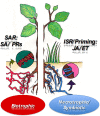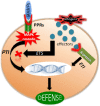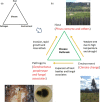Friends or foes? Emerging insights from fungal interactions with plants
- PMID: 26591004
- PMCID: PMC4778271
- DOI: 10.1093/femsre/fuv045
Friends or foes? Emerging insights from fungal interactions with plants
Abstract
Fungi interact with plants in various ways, with each interaction giving rise to different alterations in both partners. While fungal pathogens have detrimental effects on plant physiology, mutualistic fungi augment host defence responses to pathogens and/or improve plant nutrient uptake. Tropic growth towards plant roots or stomata, mediated by chemical and topographical signals, has been described for several fungi, with evidence of species-specific signals and sensing mechanisms. Fungal partners secrete bioactive molecules such as small peptide effectors, enzymes and secondary metabolites which facilitate colonization and contribute to both symbiotic and pathogenic relationships. There has been tremendous advancement in fungal molecular biology, omics sciences and microscopy in recent years, opening up new possibilities for the identification of key molecular mechanisms in plant-fungal interactions, the power of which is often borne out in their combination. Our fragmentary knowledge on the interactions between plants and fungi must be made whole to understand the potential of fungi in preventing plant diseases, improving plant productivity and understanding ecosystem stability. Here, we review innovative methods and the associated new insights into plant-fungal interactions.
Keywords: advanced microscopy; crop productivity; phytopathogenic and symbiotic fungi; plant defence response; plant receptors; plant–fungal interactions.
© FEMS 2015.
Figures






References
-
- Abbé E. Über einen neuen beleuchtungsapparat am mikroskop. Arch Mikrosk Anat. 1873;9:469–80.
-
- Adams E, Emerson D, Croker S, et al. Atomic force microscopy: a tool for studying biophysical surface properties underpinning fungal interactions with plants and substrates. Meth Mol Biol. 2012;835:151–64. - PubMed
-
- Agrios G. Plant Pathology. 5th ed. Amsterdam: Elsevier-Academic Press; 2005.
Publication types
MeSH terms
Grants and funding
LinkOut - more resources
Full Text Sources
Other Literature Sources
Medical

